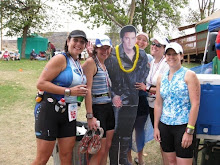INSIDE JOB
Before you head out to cover new ground, work these exercises into your training routine.
PUBLISHED 09/09/2010Roads, for the most part, are steady and predictable. Trails are not. "On the trail, every footfall is different," says Nikki Kimball, a physical therapist and ultrarunner who has won the Western States 100-Mile Endurance Run three times. "If you land on a rock or slippery moss, your body has to be able to stabilize itself." To prepare for the task, Kimball suggests adding plyometric (jumping), core strength, and flexibility exercises into your routine.
Plyometrics
"Trail running is a miniplyo workout," Kimball says. "You jump to leap over a creek, avoid mud, or to land on a rock." But if a trail run is your first plyometric workout, your muscles, ligaments, and tendons might not be strong enough to keep you upright or to handle the impact from all directions. Perform these exercises, ideally on a soft surface (dirt, grass, rubber padding at gym), once or twice a week after an easy run or on an off day.
Jump-Offs
WHY: This two-part exercise prepares the quads for the abuse they'll take on descents. Part one approximates the impact the quads experience on downhills; part two strengthens the entire leg.
HOW: Jump off a six-inch step (or curb). Then immediately jump up as high as you can. Step back up onto the step and repeat. Start with three to five repetitions (one set). After three sessions, add another set. Increase reps to eight.
Single Leg Jumps
WHY: This exercise increases ankle strength and stability as well as proprioception—the body's ability to tell where it is in space—which helps to improve your overall balance.
HOW: Stand on one foot and jump from side to side and then back and forth (in a crisscross pattern) rapidly 10 times on each leg. The goal is balance, not height or distance, so jump gently. When this becomes easy, do it with your eyes closed.
Skip and Jump
 WHY: Skipping and jumping develops explosive power and strength in the legs and hips that enable quick and safe negotiations of technical terrain.
WHY: Skipping and jumping develops explosive power and strength in the legs and hips that enable quick and safe negotiations of technical terrain.HOW: (1) Skip for height for 15 steps, then skip for distance for 15 steps. Do two or three sets. (2) This is a lateral leaping exercise. Start with feet together and jump sideways. Land, and then jump back to your starting position. Repeat 15 times. Build to three sets.
Core Strength
Lower-leg stability depends on strong hips and a stable pelvis. Without them, your lower extremities have to adjust to both trunk motion and changing ground surfaces, which increases your risk of injury. Do these exercises two or three times a week, after an easy run or on an off day. You can combine these with the plyometric exercises, or do them on their own.
Side Plank
 WHY: These build a stable core while also strengthening the glutes, which aids lower-leg stability.
WHY: These build a stable core while also strengthening the glutes, which aids lower-leg stability.HOW: From a plank position, rotate to one side, forearm on the floor, hip raised. Hold for 20 seconds; build to 60. Change sides. When this becomes easy, lift the upper leg three to six inches off the lower leg, hold for one second, and lower. Do five to 10 repetitions on both sides.
Bridge with Leg Lift
 WHY: Strengthens the glutes, the powerhouse of stability for the entire leg. Strong glutes also power climbs.
WHY: Strengthens the glutes, the powerhouse of stability for the entire leg. Strong glutes also power climbs.HOW: Lie on your back with your knees bent and feet on the floor. Lift your hips and back off the floor, squeezing your glutes as you rise. Hold for five to 10 seconds. Lower and repeat 10 times. Do two sets. When this becomes easy, straighten one leg after you lift your hips.
Flexibility
Having full range of motion decreases injury risk, says Kimball, who encourages runners to add these groin stretches to their postrun routine.
Groin Stretches
 WHY: "The groin gets ignored by most road runners," Kimball says.
WHY: "The groin gets ignored by most road runners," Kimball says.HOW: (1) Sit with the soles of your feet together. Press your knees toward the floor. Hold for 30 seconds. (2) From a wide-legged standing position, move into a side lunge. Hold each side for 30 seconds.





















No comments:
Post a Comment